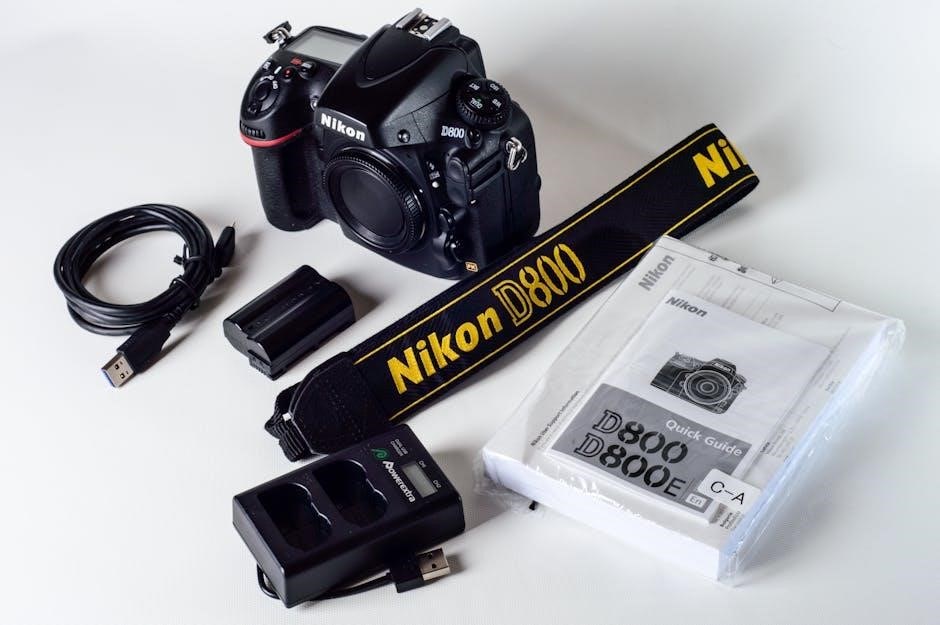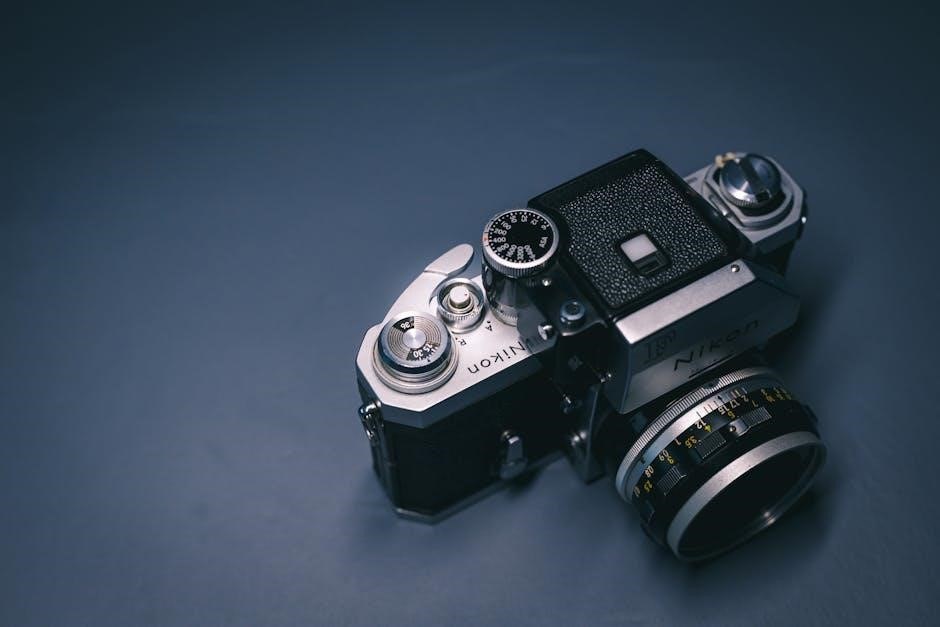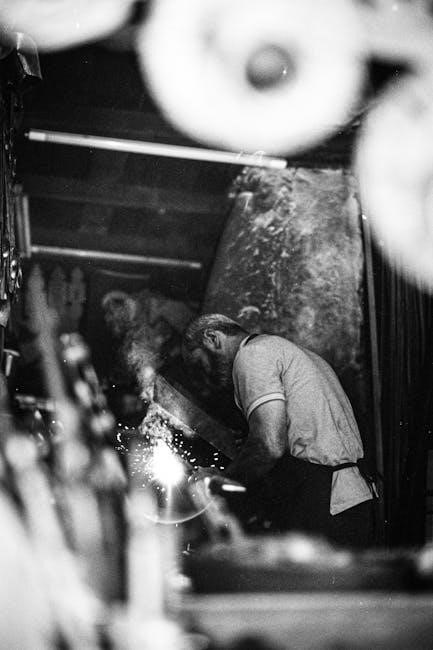The Nikon D50 Instruction Manual is an essential guide for mastering your DSLR camera. It covers camera setup, shooting modes, and troubleshooting to help you unlock its full potential.
1.1 Overview of the Nikon D50 Camera
The Nikon D50 is a compact, lightweight DSLR featuring a 6.1 MP DX-format CCD sensor (23.7 x 15.6 mm) for vivid, detailed images. It supports multiple resolutions (3008 x 2000, 2256 x 1496, 1504 x 1000) and file formats like JPEG and RAW. Equipped with an advanced 5-area autofocus system, it ensures precise focus. The camera offers 11 shooting modes, including Auto and Manual, catering to both beginners and experienced photographers. With an ISO range of 200-1600 (expandable to 3200), it performs well in low-light conditions. Compatible with AF and DX Nikkor lenses, it’s a versatile tool for photography enthusiasts.
1.2 Importance of Reading the Instruction Manual
Reading the Nikon D50 Instruction Manual is crucial for understanding the camera’s features and optimizing its performance. It provides detailed guidance on setup, shooting modes, and troubleshooting, ensuring you maximize the camera’s capabilities. The manual covers essential operations, from basic point-and-shoot to advanced techniques, helping both beginners and experienced photographers. It also offers tips for improving image quality, managing settings, and maintaining the camera. By following the manual, users can avoid common issues and enhance their photography skills, making it an indispensable resource for mastering the Nikon D50.

Camera Design and Layout
The Nikon D50 features a lightweight, compact design with an ergonomic grip for comfortable handling. Its intuitive control layout ensures easy access to key functions, enhancing usability and efficiency.
2.1 External Controls and Components
The Nikon D50 features a well-organized layout of external controls, including a mode dial, shutter release button, and aperture control. The camera includes a 2.5-inch LCD monitor for previewing and reviewing images, along with a status LCD on the top plate for quick access to settings. The ergonomically designed grip and intuitive button placement ensure easy operation. Key controls like the autofocus selector and command dial simplify navigation. The camera also includes a built-in flash and hot shoe for external accessories, providing versatility for various shooting scenarios. These components are designed to enhance both functionality and user experience.
2.2 Understanding the Camera’s Ergonomics
The Nikon D50 is designed with ergonomics in mind, offering a lightweight and compact body. The contoured grip provides a comfortable hold, reducing fatigue during extended use. Buttons and dials are strategically placed for intuitive access, allowing quick adjustments. The shutter release is positioned naturally under the index finger, while the command dial falls easily under the thumb. This design ensures smooth operation and minimizes distractions, letting you focus on capturing the perfect shot. The camera’s balance and accessibility enhance overall usability, making it ideal for photographers of all skill levels.
2.3 Visual Diagram of the Nikon D50
A visual diagram of the Nikon D50 provides a clear overview of its components. The camera features a mode dial on top for selecting shooting modes, an LCD screen on the rear for reviewing images, and a viewfinder for precise framing. External controls include a shutter release, command dial, and buttons for accessing menu, playback, and delete functions. The lens mount is centrally located, with a flash unit on top. The battery compartment and memory card slot are accessible on the bottom. This diagram helps users familiarize themselves with the camera’s layout, ensuring easy navigation and operation.

Technical Specifications
The Nikon D50 features a 6.1 MP DX-format CCD sensor, 5-area autofocus, ISO 200-1600 range, and compatibility with AF and DX Nikkor lenses, ensuring high-quality imaging performance.
3.1 Sensor and Image Quality
The Nikon D50 is equipped with a 6.1 MP DX-format CCD sensor, delivering vivid colors and clear details. Its compact size allows for sharp images, suitable for photo-quality 14 x 19-inch prints. The sensor captures sufficient detail for everyday photography, ensuring excellent performance in various lighting conditions. With proper settings, it excels in low-light environments, producing minimal noise up to ISO 1600. For optimal results, users are advised to underexpose slightly to preserve highlights, making post-processing easier. This sensor strikes a balance between resolution and performance, catering to both casual and enthusiast photographers.
3.2 Available Image Sizes and File Formats
The Nikon D50 offers three image sizes: 3008 x 2000, 2256 x 1496, and 1504 x 1000 pixels, catering to various printing and sharing needs. It supports both JPEG and RAW file formats. JPEG is ideal for everyday use, offering compressed files that save storage space, while RAW captures uncompressed data for advanced editing. The camera also allows simultaneous RAW + JPEG recording, providing flexibility for post-processing. These options ensure users can customize their output based on specific requirements, whether for professional editing or casual sharing;
3.3 ISO Range and Noise Performance
The Nikon D50 features an ISO range of 200 to 1600, allowing photographers to capture images in various lighting conditions. At lower ISOs (200-800), the camera delivers clean images with minimal noise. As ISO increases, particularly beyond 800, noise becomes more apparent but remains manageable for most practical use. Users often prefer the slightly grainy but sharp results at higher ISOs over blurry images caused by camera shake. This flexibility makes the D50 versatile for both casual and professional photography, ensuring high-quality results across a range of settings.
3.4 Autofocus System Details
The Nikon D50 features a 5-area autofocus system designed for precise and fast subject acquisition. It offers three modes: AF-A (Auto-Servo AF), AF-C (Continuous Servo AF), and AF-S (Single Servo AF), catering to different shooting scenarios. The system excels in dynamic conditions, providing accurate focus tracking. Users can manually select focus areas using the camera’s controls, enhancing customization. This advanced autofocus capability ensures sharp images, even in challenging lighting or motion-filled scenes, making it a reliable tool for photographers seeking professional-grade performance.
3.5 Metering Modes Explained
The Nikon D50 offers three metering modes to ensure accurate exposure control: Matrix Metering, Center-Weighted Metering, and Spot Metering. Matrix Metering evaluates the entire scene, considering brightness, color, and composition for balanced results. Center-Weighted Metering prioritizes the central area, ideal for portraits. Spot Metering measures a small area for precise light measurement, useful in high-contrast situations. The camera’s advanced 3D Color Matrix Metering II system enhances accuracy, adapting to various lighting conditions. Understanding these modes allows users to tailor exposure settings for optimal image capture, as detailed in the manual.
3.6 White Balance Options
The Nikon D50 provides multiple White Balance options to ensure accurate color representation in various lighting conditions. Users can choose from Auto White Balance, Preset White Balance, Daylight, Incandescent, Fluorescent, Cloudy, and Shade settings. The Preset option allows for custom measurements using a gray card or white object. Adjusting White Balance ensures natural-looking colors, whether shooting indoors or outdoors. The manual offers detailed guidance on selecting and customizing these settings for optimal results in different environments, enhancing overall image quality and color accuracy. This feature is essential for achieving professional-grade photography outcomes.

Setting Up the Camera
Unpack, charge the battery, and attach the lens. Insert a memory card, turn on the camera, and navigate basic settings for initial configuration. The manual guides you through these steps for optimal camera performance and customization.
4.1 Initial Setup and Configuration
Begin by unpacking and charging the battery. Attach the lens and insert a memory card. Power on the camera and navigate the rear LCD menu to set the date, time, and language. Familiarize yourself with basic settings for image quality, ISO, and autofocus. Refer to the manual for guidance on configuring these options to optimize performance. Proper initial setup ensures smooth operation and enhances your photography experience with the Nikon D50. This step is crucial for first-time users to customize their camera according to their preferences and shooting style.
4.2 Understanding Camera Modes
The Nikon D50 offers multiple shooting modes to suit various photography needs. Auto Mode is ideal for beginners, automatically adjusting settings for point-and-shoot convenience. Portrait Mode prioritizes subject focus with a blurred background, while Landscape Mode ensures sharpness across vast scenes. Night Portrait Mode balances flash and ambient light for low-light portraits. For creative control, Manual Mode allows full adjustment of aperture, shutter speed, and ISO. Understanding these modes enhances your ability to capture stunning images in diverse conditions, making the D50 versatile for both casual and advanced photographers.
4.3 Configuring Autofocus Settings
The Nikon D50 features an advanced 5-area autofocus system for precise subject acquisition. Users can configure autofocus settings to suit their needs, selecting between Single AF for stationary subjects and Continuous AF for moving objects. The Multi-CAM 1000 AF sensor enhances focus accuracy and speed. Customization options allow photographers to optimize AF performance, ensuring sharp images in various shooting conditions. Proper configuration of these settings is key to unlocking the camera’s full potential for capturing dynamic and focused shots with ease and precision.
4.4 Setting Up Metering and Exposure Compensation
The Nikon D50 offers versatile metering options, including 3D Matrix Metering II, Center-Weighted, and Spot Metering. Users can select the mode that best suits their scene to achieve accurate exposure. Exposure compensation allows adjustments of up to ±5 EV, enabling fine-tuning of brightness. The camera also supports exposure bracketing for capturing multiple exposures at varying settings. By mastering these features, photographers can enhance their control over lighting and achieve optimal results in diverse shooting conditions, ensuring well-balanced and visually appealing images every time.

Shooting Techniques
This chapter covers essential photography methods for the Nikon D50, including basic point-and-shoot, advanced modes, and genre-specific tips for portrait, landscape, and action photography to enhance your creativity.
5.1 Basic Point-and-Shoot Photography
Mastering basic point-and-shoot photography with the Nikon D50 is straightforward. Start by using the Auto Mode for effortless shooting, allowing the camera to handle settings like exposure and focus. Ensure your subject is well-lit and compose your shot using the rule of thirds for visually appealing results. Experiment with the built-in flash for low-light conditions and review your images on the LCD screen. For sharper images, use the viewfinder instead of the LCD and keep the camera steady. These simple techniques will help you capture stunning photos with minimal effort.
5.2 Advanced Shooting Modes
The Nikon D50 offers advanced shooting modes for greater creative control. Aperture Priority (A/Av) allows you to set the aperture while the camera adjusts the shutter speed. Shutter Priority (S/Tv) lets you control the shutter speed for freezing or blurring motion. Manual Mode (M) gives full control over both aperture and shutter speed for precise results. These modes are accessed via the mode dial and require adjusting settings using the command dial. Use the Multi-CAM 1000 AF system and 3D Matrix Metering for optimal focus and exposure in these modes.
5.3 Tips for Portrait, Landscape, and Action Photography
For portraits, use the AF-C mode with single-point AF to focus on your subject’s eyes. A small aperture like f/5.6 sharpens facial features.
In landscape photography, use AF-S mode and manual focus for sharp results. Shoot at ISO 100 and use a wide-angle lens.
For action, set shutter speed above 1/500s and enable continuous AF. Use panning to capture motion blur and burst mode for dynamic shots.
5.4 Using the Built-in Flash Effectively
The Nikon D50’s built-in flash is ideal for low-light conditions but should be used judiciously to avoid overexposure. For natural results, use it in well-lit environments to fill in shadows rather than as the primary light source. In Auto mode, the flash adjusts automatically, while Manual mode offers more control; To soften the flash, diffuse it using a diffuser or white card. Avoid direct flash on reflective surfaces to prevent harsh highlights. Adjust flash compensation to balance exposures and achieve desired effects. Experiment with bounce flash techniques for more flattering lighting in portraits and indoor settings.
5.5 Working with RAW Files
Shooting in RAW format with the Nikon D50 provides unparalleled image quality and flexibility. RAW files capture all sensor data, allowing for extensive post-processing adjustments. To enable RAW mode, navigate to the camera’s file format menu and select the RAW option. Keep in mind that RAW files are larger, requiring more memory and storage. Use Nikon Capture NX or other compatible software for editing. For optimal results, shoot in RAW when you need precise control over white balance, exposure, and color correction. This format is ideal for professional-grade photography and ensures maximum detail retention in your images.

Troubleshooting Common Issues
This section addresses common issues like blurred images, exposure problems, and autofocus errors. It provides practical solutions and tips to restore optimal camera functionality and image quality.
6.1 Resolving Blurred Images
Blurred images on the Nikon D50 can often be resolved by checking the lens for cleanliness and ensuring proper focus. Use a soft cloth to clean the lens and verify autofocus settings. If using manual focus, ensure the subject is sharp. Adjust shutter speed to avoid camera shake, especially in low light. Enable image stabilization if available. Check for firmware updates and consult the manual for calibration steps. Restarting the camera may also resolve temporary glitches. Addressing these factors can help restore image clarity and sharpness for optimal results.
6.2 Fixing Exposure Problems
Exposure issues on the Nikon D50 can often be corrected by adjusting settings like exposure compensation or ISO sensitivity. Use the camera’s metering modes to ensure accurate light reading. For underexposed images, increase exposure compensation, and for overexposed shots, decrease it. Check the histogram to gauge exposure accuracy. Avoid using high ISOs in bright conditions to prevent overexposure. If images are consistently dark or bright, recalibrate your shooting techniques or consult the manual for advanced metering options. Proper use of these tools ensures well-balanced and vivid photos every time.
6.3 Solving Autofocus Errors
Autofocus issues on the Nikon D50 can often be resolved by cleaning the camera’s sensor and lens to remove dirt or smudges. Ensure the autofocus mode is set correctly for your subject, using AF-C for moving subjects and AF-S for stationary ones. Check that the autofocus area is properly aligned with your subject. If problems persist, reset the camera to default settings or update the firmware. Using compatible Nikon lenses and avoiding third-party accessories can also improve autofocus performance. Regular maintenance and proper handling will help maintain accurate focus in your photography.
6.4 Managing Battery Life
To maximize battery life on your Nikon D50, turn off the LCD when not in use and rely on the optical viewfinder. Avoid frequent image previewing and use the auto-off timer to shut down unused functions. Keep the camera away from extreme temperatures and ensure the battery contacts are clean. Use genuine EN-EL3 batteries for optimal performance and avoid overcharging. Regularly updating your camera’s firmware can also improve power efficiency. By following these tips, you can extend shooting sessions and reduce the need for frequent recharging.

Advanced Features
Unleash your creativity with the Nikon D50’s advanced features, including manual exposure modes, customizable settings, and firmware updates. Explore hidden capabilities to enhance your photography experience.
7.1 Using Manual Exposure Modes
Manual exposure modes on the Nikon D50 offer precise control over aperture, shutter speed, and ISO. Access manual mode via the mode dial and adjust settings for optimal results; Use the aperture to regulate depth of field, shutter speed for motion effects, and ISO for low-light sensitivity. Experiment with these controls to achieve desired artistic effects. For better control, deactivate AUTO ISO in manual mode to avoid unexpected adjustments. This mode is ideal for experienced photographers seeking creative freedom and technical precision in their work.
7.2 Customizing Camera Settings
The Nikon D50 allows extensive customization to tailor settings to your preferences. Adjust autofocus modes, metering options, and white balance for specific shooting scenarios. Users can also customize button functions and save preferred configurations for quick access. For advanced control, explore options like AF-C priority selection and flash exposure compensation. Additionally, the camera supports non-G lenses by utilizing the aperture ring, ensuring compatibility with a wide range of optics. These customization features enhance workflow efficiency and adaptability, making the D50 versatile for various photography needs and styles.
7.3 Updating Firmware
Updating the Nikon D50 firmware ensures optimal performance and resolves potential issues. Download the latest firmware from Nikon’s official website and transfer it to a memory card. Follow the manual’s step-by-step instructions to complete the update. Always use a fully charged battery and avoid interruptions during the process. Firmware updates may enhance autofocus accuracy, improve noise reduction, and expand compatibility with newer lenses or accessories. Regularly checking for updates helps maintain your camera’s functionality and ensures you benefit from the latest improvements and fixes.
7.4 Accessing Hidden Features
The Nikon D50 offers several hidden features that can enhance your shooting experience. These include customizing button functions, enabling advanced autofocus modes, and accessing specialized shooting options. To unlock these features, navigate through the camera’s menu system or use specific button combinations. For example, pressing the FUNC button while adjusting settings can reveal additional customization options. These hidden features allow for greater control over camera settings, enabling you to tailor the D50 to your unique photography style and needs. Experimenting with these options can significantly improve your creative output and overall satisfaction with the camera.

Maintenance and Care
Regularly clean the camera and lens to prevent dust and smudges. Store the camera in a dry, cool place, away from direct sunlight. Perform routine checks to ensure optimal functionality.
8.1 Cleaning the Camera and Lens
Cleaning your Nikon D50 and its lens is crucial for maintaining image quality. Use a soft, dry microfiber cloth to wipe away dust and smudges from the camera body and lens surfaces. For stubborn spots, dampen the cloth with distilled water, but avoid harsh chemicals or excessive moisture. A bulb blower can gently remove loose debris from the lens and sensor area. Regular cleaning prevents scratches and ensures clear, sharp images. Always handle the lens with care, avoiding direct sunlight during cleaning to prevent damage.
8.2 Storing the Camera Properly
Proper storage is vital to maintain the Nikon D50’s condition and functionality. Store the camera in a cool, dry place, away from direct sunlight and humidity. Use a silica gel packet to absorb moisture and prevent mold. Keep the camera in a protective case or bag to shield it from dust and physical damage. Remove the battery when storing for extended periods to prevent leakage. Always attach the lens cap to protect the lens from scratches and debris. Regularly inspect the camera and lens for signs of wear and ensure all components are clean before storage.
8.3 Regular Maintenance Tips
Regular maintenance ensures your Nikon D50 remains in optimal condition. Clean the camera body and lens with a soft, dry cloth, avoiding harsh chemicals. Use compressed air to remove dust from the sensor and exterior components. Check for firmware updates to enhance performance and fix issues. Store batteries in a cool, dry place and avoid extreme temperatures. Inspect and clean the memory card slots periodically. Use only Nikon-approved accessories to prevent damage. Schedule professional cleaning every 12-18 months for internal components. Keep the camera and lens caps on when not in use to protect from dust and scratches. Regularly format memory cards in the camera to maintain optimal performance.

Resources and Support
Access the official Nikon D50 manual online for detailed guidance. Explore online forums and communities for troubleshooting and tips. Utilize Nikon’s repair services for professional assistance. Contact customer support for personalized help and inquiries.
9.1 Official Nikon D50 Manual Download
The official Nikon D50 manual is available for free download on Nikon’s website and trusted sources. This comprehensive guide provides detailed instructions for setting up and using your camera. It covers essential functions, shooting modes, and advanced features. The manual also includes troubleshooting tips and maintenance advice to ensure optimal performance. By downloading the official manual, you gain access to clear, concise information tailored to your Nikon D50. This resource is indispensable for both beginners and experienced photographers, helping you maximize your camera’s capabilities and improve your photography skills.
9.2 Online Communities and Forums
Online communities and forums are invaluable resources for Nikon D50 users. Platforms like Nikon’s official forum, Reddit, and Facebook groups offer spaces to ask questions, share experiences, and learn from other photographers. These communities provide tips, troubleshooting advice, and creative inspiration. Many forums also host tutorials, firmware updates, and user-generated guides. Engaging with these communities can enhance your understanding of the camera and help you overcome challenges. Active participation fosters a supportive environment where photographers of all skill levels can grow and improve their craft together.
9.3 Repair and Service Options
For repairs, Nikon offers authorized service centers that ensure high-quality maintenance for your D50. DIY repairs are possible but risky without expertise. The user manual provides basic troubleshooting, but complex issues may require professional attention. Contact Nikon support for genuine parts and authorized technicians. Regular maintenance, like cleaning sensors and lenses, prevents damage. Extended warranties and service plans are available for added protection. Visit Nikon’s official website or authorized dealers for reliable repair services and to ensure your camera performs optimally;
The Nikon D50 manual provides comprehensive guidance, empowering users to master their camera. Regular practice and experimentation will enhance your photography skills and creativity.
10.1 Summary of Key Takeaways
The Nikon D50 manual is a comprehensive guide that covers everything from initial setup to advanced features. It emphasizes understanding camera components, shooting modes, and settings like ISO, autofocus, and metering. Regular maintenance and troubleshooting tips are highlighted to ensure optimal performance. The manual also provides practical photography techniques for various genres, helping users capture stunning images. By following the guide, photographers can unlock the D50’s full potential, enhance their skills, and produce high-quality results consistently. Regular practice and experimentation with the camera’s features are encouraged to master its capabilities.
10.2 Encouragement to Practice
Practicing with your Nikon D50 is essential to unlocking its full potential. Regular use helps refine your skills in autofocus modes and ISO settings, leading to sharper, more vibrant images. Experimentation with different shooting modes and techniques will enhance your creativity. Consistent practice builds confidence, allowing you to capture stunning portraits, landscapes, and action shots. Take your camera on outings, explore various lighting conditions, and challenge yourself to try new things. The more you practice, the more comfortable and proficient you’ll become with your D50, making every shot a potential masterpiece.

Frequently Asked Questions (FAQs)
This section addresses common queries about the Nikon D50, such as resolving blurred images, managing ISO settings, and troubleshooting autofocus issues, providing clear solutions.
11.1 Common Questions About the Nikon D50
Users often ask about ISO settings, autofocus accuracy, and display configurations. Common inquiries include how to achieve sharp images, manage noise at high ISOs, and resolve blurry photos. Questions also arise about manual mode, RAW file handling, and compatibility with older Nikon lenses. Many seek tips for improving portrait and action photography, while others inquire about the camera’s battery life and storage recommendations. Additionally, users frequently ask how to access advanced features and troubleshoot issues like slow shutter speeds or incorrect metering. These questions highlight the D50’s versatility and user-friendly design.
11.2 Solutions to Frequently Encountered Problems
Common issues with the Nikon D50 include blurred images, incorrect ISO settings, and autofocus errors. To resolve these, ensure proper shutter speed for sharpness, clean the sensor regularly, and use autofocus lock for precise focus. For display configuration, refer to the manual to adjust settings. Rebooting the camera often fixes temporary glitches. Adjusting white balance and metering modes can improve exposure accuracy. Using manual focus or updating firmware may address persistent autofocus problems. Refer to the official manual or online forums for detailed troubleshooting guides tailored to specific issues.
